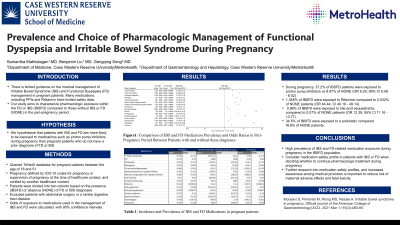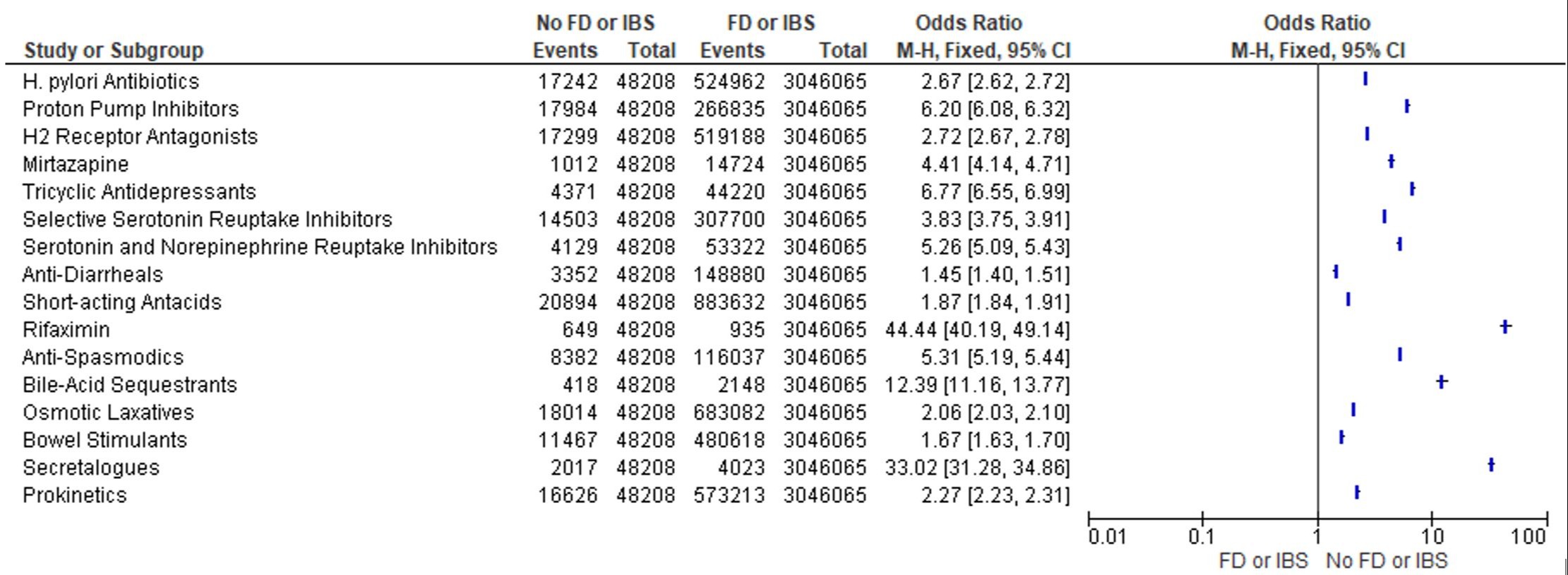Monday Poster Session
Category: Functional Bowel Disease
P1952 - Prevalence and Choice of Pharmacologic Management of Functional Dyspepsia and Irritable Bowel Syndrome During Pregnancy
Monday, October 23, 2023
10:30 AM - 4:15 PM PT
Location: Exhibit Hall

Has Audio

Samantha Mathialagan, MD
MetroHealth Medical Center
Cleveland, OH
Presenting Author(s)
Samantha Mathialagan, MD1, Benjamin D. Liu, MD2, Gengqing Song, MD3
1MetroHealth Medical Center, Cleveland, OH; 2MetroHealth, Cleveland, OH; 3MetroHealth Medical Center, Case Western Reserve University, Cleveland, OH
Introduction: Irritable Bowel Syndrome (IBS) and Functional Dyspepsia (FD) patients are likely to be younger and female. Nevertheless, there is limited guidance on the pharmacologic management of IBS and FD management in pregnant patients. Some medications may be teratogenic, while others have no safety data. Our study aims to characterize and quantify pharmacologic agent exposure within the FD or IBS (IBSFD) population as compared to those without IBS or FD (NONE) in the peri-pregnancy period.
Methods: We queried TriNetX, a global population healthcare database for pregnant patients between the age of 18 and 51. Pregnancy was defined by ICD-10 codes for pregnancy or supervision of pregnancy at the time of healthcare contact and verified by another healthcare contact, with an associated pregnancy diagnosis, within 9 months. Patients were divided into two cohorts based on the presence (IBSFD) or absence (NONE) of FD or IBS diagnoses. Patients could not have a systemic or digestive tract disease that could cause symptoms similar to IBS or FD, nor have undergone major abdominal surgery. Within 9 months of healthcare contact, the odds of exposure to medications used in the management of IBS and FD were calculated. Odds ratios were obtained with 95% confidence intervals.
Results: Exposure to IBS or FD medications was significantly elevated in IBSFD compared to NONE. 17,984 of 48,208 IBSFD patients (37%) were exposed to proton pump inhibitors compared to 266,835 of 3,046,065 (9%) of NONE (OR 6.20; 95% CI 6.08 - 6.52). 1.4% of IBSFD were exposed to Rifaximin compared to 0.032% of NONE (OR 44.44; CI 40.19 - 49.14). Likewise, 0.86% of IBSFD were exposed to bile acid sequestrants, compared to 0.07% of NONE (OR 12.39; 95% CI 11.16 - 13.77). 35% and 4.2% of IBSFD were exposed to a prokinetic or secretagogue respectively, compared to 19% and 0.13% of NONE. Finally, IBSFD patients were more likely to be exposed to tricyclic antidepressants (OR 6.77; 95% CI 6.55 – 6.99).
Discussion: Our data suggests a high prevalence of IBS and FD-related medication exposure during pregnancy in the IBSFD population. This highlights the importance of understanding medication safety profile in patients with IBS or FD when deciding whether to continue pharmacologic treatment during pregnancy. Consequently, further research into medication safety profiles, and increased awareness among medical providers is critically important to reduce risk of maternal adverse effects and fetal toxicity.

Disclosures:
Samantha Mathialagan, MD1, Benjamin D. Liu, MD2, Gengqing Song, MD3. P1952 - Prevalence and Choice of Pharmacologic Management of Functional Dyspepsia and Irritable Bowel Syndrome During Pregnancy, ACG 2023 Annual Scientific Meeting Abstracts. Vancouver, BC, Canada: American College of Gastroenterology.
1MetroHealth Medical Center, Cleveland, OH; 2MetroHealth, Cleveland, OH; 3MetroHealth Medical Center, Case Western Reserve University, Cleveland, OH
Introduction: Irritable Bowel Syndrome (IBS) and Functional Dyspepsia (FD) patients are likely to be younger and female. Nevertheless, there is limited guidance on the pharmacologic management of IBS and FD management in pregnant patients. Some medications may be teratogenic, while others have no safety data. Our study aims to characterize and quantify pharmacologic agent exposure within the FD or IBS (IBSFD) population as compared to those without IBS or FD (NONE) in the peri-pregnancy period.
Methods: We queried TriNetX, a global population healthcare database for pregnant patients between the age of 18 and 51. Pregnancy was defined by ICD-10 codes for pregnancy or supervision of pregnancy at the time of healthcare contact and verified by another healthcare contact, with an associated pregnancy diagnosis, within 9 months. Patients were divided into two cohorts based on the presence (IBSFD) or absence (NONE) of FD or IBS diagnoses. Patients could not have a systemic or digestive tract disease that could cause symptoms similar to IBS or FD, nor have undergone major abdominal surgery. Within 9 months of healthcare contact, the odds of exposure to medications used in the management of IBS and FD were calculated. Odds ratios were obtained with 95% confidence intervals.
Results: Exposure to IBS or FD medications was significantly elevated in IBSFD compared to NONE. 17,984 of 48,208 IBSFD patients (37%) were exposed to proton pump inhibitors compared to 266,835 of 3,046,065 (9%) of NONE (OR 6.20; 95% CI 6.08 - 6.52). 1.4% of IBSFD were exposed to Rifaximin compared to 0.032% of NONE (OR 44.44; CI 40.19 - 49.14). Likewise, 0.86% of IBSFD were exposed to bile acid sequestrants, compared to 0.07% of NONE (OR 12.39; 95% CI 11.16 - 13.77). 35% and 4.2% of IBSFD were exposed to a prokinetic or secretagogue respectively, compared to 19% and 0.13% of NONE. Finally, IBSFD patients were more likely to be exposed to tricyclic antidepressants (OR 6.77; 95% CI 6.55 – 6.99).
Discussion: Our data suggests a high prevalence of IBS and FD-related medication exposure during pregnancy in the IBSFD population. This highlights the importance of understanding medication safety profile in patients with IBS or FD when deciding whether to continue pharmacologic treatment during pregnancy. Consequently, further research into medication safety profiles, and increased awareness among medical providers is critically important to reduce risk of maternal adverse effects and fetal toxicity.

Figure: Figure 1: Comparison of IBS and FD Medication Prevalence and Odds Ratios in Peri-Pregnancy Period Between Patients with and without These Diagnoses.
H. Pylori Antibiotics = Metronidazole, Clarithromycin, Levofloxacin, Tetracycline, Doxycycline, Tinidazole, Nitazoxanide, Rifabutin.
Anti-Diarrheals = Loperamide, Diphenoxylate, Bismuth Salicylate.
Bile Acid Sequestrants = Cholestyramine, Colesevelam, Colestipol.
Bowel Stimulants = Bisacodyl, Sennosides.
Secretagogues = Linaclotide, Plecanatide, Lubiprostone, Tenapanor.
Prokinetics = Metoclopramide, Erythromycin, Domperidone, Buspirone, Sulpiride, Levosulpiride, Itopride, Cisapride, Tegaserod, Prucalopride.
H. Pylori Antibiotics = Metronidazole, Clarithromycin, Levofloxacin, Tetracycline, Doxycycline, Tinidazole, Nitazoxanide, Rifabutin.
Anti-Diarrheals = Loperamide, Diphenoxylate, Bismuth Salicylate.
Bile Acid Sequestrants = Cholestyramine, Colesevelam, Colestipol.
Bowel Stimulants = Bisacodyl, Sennosides.
Secretagogues = Linaclotide, Plecanatide, Lubiprostone, Tenapanor.
Prokinetics = Metoclopramide, Erythromycin, Domperidone, Buspirone, Sulpiride, Levosulpiride, Itopride, Cisapride, Tegaserod, Prucalopride.
Disclosures:
Samantha Mathialagan indicated no relevant financial relationships.
Benjamin Liu indicated no relevant financial relationships.
Gengqing Song indicated no relevant financial relationships.
Samantha Mathialagan, MD1, Benjamin D. Liu, MD2, Gengqing Song, MD3. P1952 - Prevalence and Choice of Pharmacologic Management of Functional Dyspepsia and Irritable Bowel Syndrome During Pregnancy, ACG 2023 Annual Scientific Meeting Abstracts. Vancouver, BC, Canada: American College of Gastroenterology.
